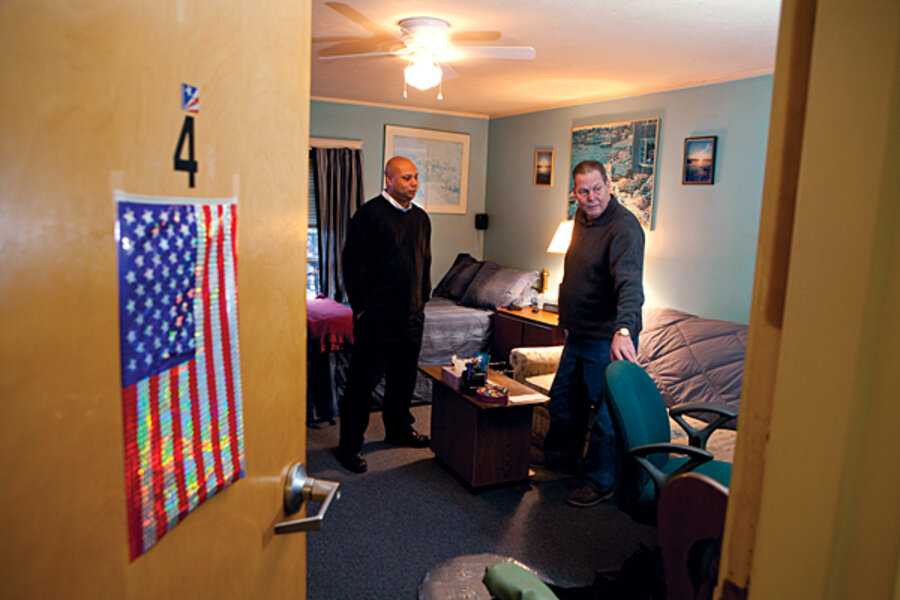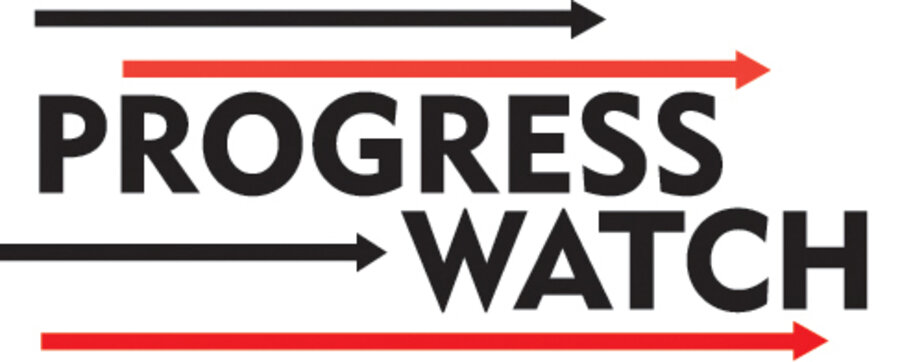How to curb chronic homelessness? First, a home!
Loading...
| Quincy, Mass.
The simple though revolutionary concept that the most lasting cure for homelessness is, in fact, a home has helped the federal government and private groups make significant headway against homelessness during the past decade.
For years, the battle against homelessness was fought against symptoms. The answer to getting people off the streets, it was believed, was treating the underlying problems that faced the homeless, such as mental illness or drug and alcohol addiction.
But last year, the number of so-called permanent supportive housing units in the United States exceeded the number of emergency shelters for the first time. The reason is simple, advocates say: Permanent supportive housing not only removes the stigma of homelessness but is also cheaper than other alternatives, studies show.
Thanks by and large to this dramatic shift in thinking about solutions to homelessness, the number of long-term homeless has decreased by nearly 39 percent since 2005. Perhaps most surprising, homelessness has stayed flat since 2009, despite the tremendous economic pressures of the recession's aftermath.
"There has been a complete paradigm shift in this country away from using emergency, big congregate shelters just to get people off of the street," says Brian Sullivan, spokesman for the US Department of Housing and Urban Development (HUD). "This system is merely a band-aid with a big revolving door, and modeling our entire system of care on this wasn't having any meaningful impact in reducing homelessness, especially among the chronically homeless."
Permanent supportive housing provides immediate access to affordable rental housing without requiring participation in psychiatric or sobriety treatment, a common deterrent for many homeless people, says HUD's Mr. Sullivan. After settling in, clients are offered a range of services to help them maintain their housing, including mental health and substance abuse counseling, health care, and job training.
The model for permanent supportive housing began taking shape decades ago, when groups serving the homeless began bringing in services to try to address those who experienced multiple stints of homelessness over short periods of time.
To critics, there is some concern about backing away from the treatment-first model. Moreover, some say that permanent supportive housing ventures could face tough times as federal stimulus money runs out. But data suggest that supportive housing has so far had a positive impact, particularly on chronic homelessness.
The chronically homeless are defined as those who have been continuously homeless for a year or more or have had at least four episodes of homelessness in the past three years. They represent only about 18 percent of the overall homeless population but consume more than half the homeless-assistance system's resources every year.
Comparing statistics on chronic homelessness over decades is impossible, HUD says, because it did not have consistent reporting methods before 2005. But since then, the number of chronically homeless in the US has fallen from 175,914 to 107,148.
A Jan. 18 press release by the National Alliance to End Homelessness cited permanent supportive housing as the greatest factor in the recent decline of chronic homelessness. Four cities considered leaders in permanent supportive housing have seen noteworthy drops in chronic homelessness: Chicago (12 percent); Norfolk, Va. (25 percent); Quincy, Mass. (50 percent); and Wichita/Sedgwick County, Kan. (51 percent).
Supportive housing is working, says Dennis Culhane, a professor at the University of Pennsylvania in Philadelphia, who has conducted extensive research on homelessness and housing-assistance policy.
"The fact that homelessness has stayed solid and didn't increase in such a deep recession is a major accomplishment," he says. "Treatment programs and shelters help a lot of people, but many chronically homeless individuals would die on the street before getting into housing under the normal homeless system."
For Barry Boudreau of Quincy, Mass., homelessness came at the worst possible time. After serving for two years in the Vietnam War, he returned in 1970 to his home in Somerville, Mass., where he married and opened his own bakery. After a few years, he was forced out of business by larger conglomerates, he says. That same year, he divorced from his wife with whom he'd had three children. Mr. Boudreau says he started drinking and quickly ended up without a home.
"Veterans, myself included, can be pigheaded and sometimes proud to a fault," he says. "I didn't want to be a burden on or inconvenience my children, so I ended up at a veterans shelter in Boston."
One day in February 2003, he accompanied a friend on the friend's appointment to obtain permanent housing at a shelter in Quincy. Boudreau was asked if he'd ever consider moving into the permanent housing shelter as well. About a week later, Boudreau had a new home at Father Bill's & MainSpring, an organization devoted to ending homelessness through permanent and temporary supportive housing.
"That was huge, to be able to walk in and up the stairs to my own apartment, sit down, and shut the door," Boudreau says. "You don't realize how meaningful that is. I'm grateful every day."
Sometimes the "homes" are just single rooms, but as permanent residences, they can change the equation for homelessness, says Sullivan of HUD. "The goal is to get people to stabilize themselves and confront the root cause of their homelessness as opposed to making housing conditional in whatever way."
Various studies have also shown that providing homeless people with permanent housing saves money:
•In Seattle, the housing-first-style 1811 Eastlake program saw savings of nearly $30,000 per tenant per year compared with conventional shelters, says an article in the Journal of the American Medical Association.
•In Portland, Maine, a study of rural homelessness found a 57 percent reduction in the cost of mental-health services when providing permanent supportive housing as opposed to serving homeless people.
•A study of nine major cities by the Lewin Group, a health-care consulting firm, found that supportive housing was consistently the cheapest option when compared with such services as jails, prisons, shelters, and hospitals. The cities included were Atlanta; Boston; Chicago; Columbus, Ohio; Los Angeles; New York; Phoenix; San Francisco; and Seattle.
For Boudreau, the new approach saved his life, he says. "There is such a stigma attached to homeless shelters," he says. "But Father Bill's isn't a shelter; it's a home. And I don't know what would have happened to me if they weren't there. To think back what they've done for my life, I just sit here and say, 'Thank God.' "






